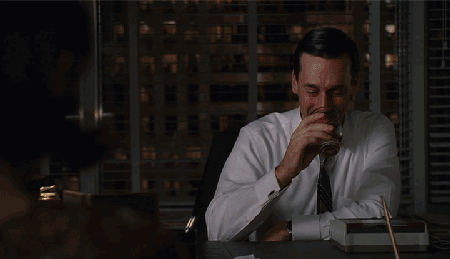In Parts 1 and 2 of this series, I talked about how ads come with costs, are generally a burden on a happy lifestyle, and should be blocked where possible. I’m confident in the opinions I described there, but this third post will be more speculative.
Part 3: Ads and art
I recently started wondering whether there might be some exceptions to my strong aversion to ads. At work, an email went around asking us to take a quick survey on what kinds of advertising we’d like to see. My gut response was: “None, and nothing will change that, and the advertiser and consumer will always be in conflict—one trying to show the ads and the other trying to avoid them.” But after giving it more thought I remembered a few examples of ads that I was actually glad to have seen.
For all the issues I’ve laid out thus far, there are still some ads that I’ve thought were worth seeing. This is good news, because even though I’d personally have no problem disparaging the effects of ads without providing advertisers any alternatives, I think the criticism will be better received if I can give some good alternatives.
And I think I can offer something more comprehensive than, “I liked this ad cause it was funny, but I dislike that ad cause it wasn’t.” I’ve noticed an interesting pattern in the ads that I’ve liked, and I haven’t seen it talked about elsewhere. This is about the very relationship between the brand itself and the art that’s expected to promote it.
Not “funny” ads
But first, let me address that obvious answer: We like ads that are funny. Advertisers know this, so they often try to use humor to associate a brand with positive feelings. And yes, some ads are funny… But aren’t most ads just not? Does the commercial break ever really feel like entertainment on its own? In my view, most ads that try to be funny end up looking something like this abomination:
LOL, he doesn’t pay attention to her because the sandwich is good. Does anyone actually find this funny? Message me right now if you find this funny. But even if you do, that just means that you and I are very different, and the ads that I think are funny will be completely unfunny to you, and you’ll find yourself in the same situation.
And, mind you, I’m not saying this ad won’t work. It still put some very appetizing images of chicken tenders in front of my face, and the dialogue kept me listening. I do want chicken tenders right now. But did the cringe-y attempt at humor do anything to help this? Well… maybe. Maybe it’s the case that we remember things better when they make us cringe. But isn’t that an unnecessary risk for the advertiser to take? Wouldn’t actual humor always be preferable?
But personal experience tells me that actual humor isn’t an easy note for advertisers to hit. I think for every trying-to-be-funny ad that makes me laugh, there are 99 that make me cringe, groan, and resent them for wasting my time. There’s an easy explanation for this: Ads want to appeal to the widest possible audience, so their content tends to cater to the greatest common denominator—jokes that everyone will understand. This makes for content that is trivial, sanitized, and vague; good comedy is none of these things.
If you ask me, it’s not even worthwhile to encourage or celebrate the successfully funny ads if 99% of similar attempts will give us unfunny garbage. But there is a way of doing ad humor that, as far as I can tell, can’t actually fail like our friend Popeyes does.
Pattern: The ad is the joke
There are some cases where the ad doesn’t present a funny situation or joke, but actually is the joke, presented by someone else—someone who’s good at being funny. I can describe this pattern with some examples that I’ve dug up from recent memory.
The Earliest Show
Last year I came across a comedy YouTube series called The Earliest Show. It’s an improv-based parody of the typical overly cheerful morning news show, and it contains ads for Cap’n Crunch breakfast cereal. But the ads are a part of the parody: The show is intentionally hokey and ridiculous with how often and in what contexts it plugs Cap’n Crunch. At the same time, though, the ads are real: Cap’n Crunch actually sponsored this web series in hopes of promoting their brand.
This is a fundamentally different process of doing comedy. It wasn’t Cap’n Crunch executives poring over their market research to settle on a script that’s “funny” in a safe and reliable way. It was put together in an authentic, “We just think this would be funny,” kind of way, by people who make their living in comedy—namely the show’s creator and co-star Ben Schwartz. The whole sponsorship relationship was framed in the context of the art, not the other way around. That’s the big difference.
And, if Ben’s brand of humor isn’t your thing, there’s no harm done, because you probably wouldn’t have seen the ad anyway. If it is your thing, you’ll probably come away with very a positive feeling about Cap’n Crunch (more on that later). Yes, I went out and bought a box.
Arrested Development
The Fox/Netflix sitcom Arrested Development did a similar thing with Burger King in its season 2 episode “Motherboy XXX.” Two characters, both hopelessly trying to make it big in Hollywood, go to Burger King and discuss plans to create a documentary about the main events of the show, with BK as their sponsor (Arrested Development is famous for its meta-references). Through the characters’ ham-fisted praise of Burger King and jarring cutaways to a still shot of the restaurant, the show pokes fun at not only the brand itself, but also the very idea of using product placement to fund a show.
Nevertheless, this was a real ad: Burger King really did pay to have their brand tossed into the storm of hilarious cynicism and absurdity that is Arrested Development.
Bill Burr’s Monday Morning Podcast
Legendary stand-up comedian Bill Burr produces a twice-weekly podcast called the Monday Morning Podcast, in which he rants about current events, sports, relationships, and his life as a comic, husband, and father. At some point in the middle of the show, he reads ads. When most podcasters read ads, there’s a clear difference in tone between the host’s genuine conversation and the advertiser’s script. But as a brash, candid comedian, Bill reads the ads in… his way.
This is easier shown than explained. You can find the podcast on Bill’s YouTube channel, but for the sake of time you can listen to this short ad read segment that someone trimmed out:
Even if you don’t find Bill Burr funny, his podcast audience certainly does. And they find his ads funny too, because the ads are 100% him. And so, inevitably, these brands get the positive associations they’re looking to establish with this audience. If you browse the comments of his podcast videos, you’ll often see lines like, “Bill’s ad-reads are so ridiculous I actually started using Dollar Shave Club,” or better yet, “These are the only ads I actually like.” I have to believe this is a far better outcome than most trying-to-be-funny ads ever achieve. Evidently, a handful of companies agree.
Genuine appreciation
Advertisers take unique risks when they allow their brands to be used in this “ad is the joke” format.
- They need to assume a certain level of honest humility, which runs counter to the default message of, “You need our products in order to be happy.” When they leave the humor (and the very messaging of the ad) to those who actually do it for a living (Ben Schwartz, Bill Burr, or the writers of Arrested Development), they make it clear that they’re simply a company that creates a product and buys ads—nothing more.
- They need to trust that the content creators will deliver—that they’ll do their best to make the jokes funny and not just cynical.
- They need trust the audience itself—that viewers will have the maturity and intelligence to recognize that even though the brand is the butt of the joke, the brand also funded the joke and therefore deserves some appreciation.
Honesty; humility; trust. Who wouldn’t want to do business with someone who has these qualities? And here’s the most important part: With ordinary ads, no matter how carefully written, companies can only suggest positive qualities. But here, they actually demonstrate them by taking the risks involved. This is a new style of brand-building, a more authentic style, and I’m a fan of it.
Generalizing the pattern
I suspect this kind of pattern can work with any kind of art, not just comedy. Let the artist do what they want with your brand, and you get a great work of art that happens to involve your brand, rather than a work that suffers from being obligated to say certain things about the brand. I have one pseudo-example to demonstrate this; you’ll see what I mean.
Mad Men
Yes, after stealing their photos for use in these last three posts, I actually do have something to say about AMC’s drama series Mad Men. There are some spoilers ahead, along with a lot of exposition that I promise is necessary.
In the season 7 episode “The Strategy,” up-and-coming ad creator Peggy Olson has to invent a new ad campaign for the fast-food chain Burger Chef. Much of the episode is about her strained relationship with Donald Draper, the highly talented ad man who was once her boss but now works beneath her. He’s irritated by his new role, and she worries that she’s inadequate at hers.
The episode also highlights how Peggy’s, Don’s, and their colleague Pete’s family lives are all crumbling or nonexistent. This very topic then comes up explicitly in a beautifully, painfully honest conversation between Don and Peggy in which they confess some of their worst fears and regrets. Here we see a lot of reconciliation in what is easily the most important relationship of the series, and in the midst of it Peggy thinks of an ad idea. She hints, “What if there was a place where you could go, where there was no TV, and you could break bread, and whoever you were sitting with was family.”
A few scenes later the episode ends with Peggy and Don taking Pete out to Burger Chef to explain her ad to him. “It’s about family. Every table here is the family table,” she says, as the three sit at a table together. Then we cut to a shot of their table from just outside the restaurant window: We can’t hear their conversation anymore; we only see that the expressions and body language of these long-time friends very much resemble those of a loving family. A sweet, wistful classical tune fades in as the camera slowly pulls back to reveal more and more tables of families, similarly happy to be sitting down and eating together, all within and around the symmetrically framed Burger Chef building.
That scene is Peggy’s ad. It beautifully and precisely depicts her tagline—”whoever you’re sitting with is family.”
So, to summarize, this is a scene in which Peggy explains her ad, an ad which is that very scene. The writers of Mad Men are geniuses. But look, this is almost an instance of the same pattern I described above. Technically, it’s not an ad, because Burger Chef restaurants aren’t around anymore. Suppose, though, that it had been McDonald’s instead. Then we’d have an ad, a real ad, whose content was entirely dictated by the plot of the TV show.
Unlike my other examples, there’s no attempt at humor here. But there is still a work of art—art that someone put together carefully and without any brand affiliation. The ad is part of the art, not the other way around. That’s why if this had been McDonald’s and everything else were left the same, I would honestly see it as a beautiful ad—maybe the only one I’ve ever seen in my life.
Wrapping up
I think I’m onto something with this “ad is the joke” / “ad is the art” thing. In any case, it was fun for me to explore this pattern and examine my own responses to the different kinds of ads I see. This is end of my series on ads, and I hope you’ve found it valuable.


